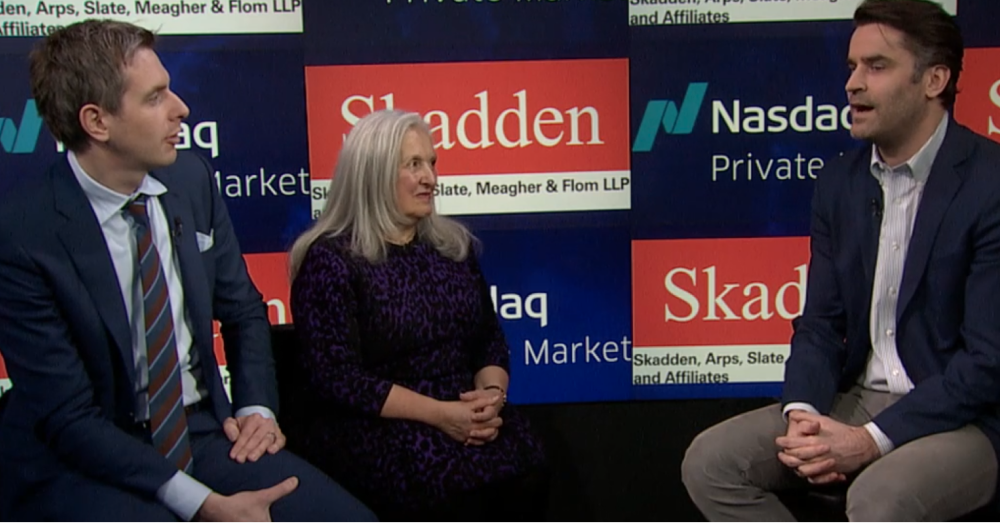This conversation was originally recorded in 2017 and may contain certain information that, although was correct at the time, has since been updated.
Transcript
Kevin:
Hi, I am Kevin Gsell with Nasdaq Private Market and I am joined today by Phyllis Korff and Ryan Dzierniejko of Skadden Arps. We have been talking along with my colleague, Annemarie Tierney, a lot about tender offer disclosure rules. And just want to touch a little bit on the process in general, as far as, how we get engaged, usually, by a company and council, as we have worked with you on a few different programs. So, one of the key features on the program in general is that in the context of a private tender offering, we act as the information and paying agent and so, generally usually, an outside law firm will reach out to us on behalf of one of their clients to engage us. In which then we will usually, get an IDPAA signed, which is the Information Depository and Paying Agent Agreement. And then along with that the general things we need to launch, and we always tell folks…
Phyllis:
And the company signs that?
Kevin:
Correct.
Phyllis:
Ok.
Kevin:
Company and if there are buyers as well.
Phyllis:
Right.
Kevin:
And in general, we will get the offer to purchase as well, if there is an option exercise agreement as well and then we’ll gather that shareholder data from the company. So, whatever, whoever, is on the cap table, whoever is managing the cap table will gather that data, put all the shareholder information in. We tell you, we tell the company usually it takes roughly 2 weeks to start a program. Sometimes we can kick them off a lot quicker if we get that data, but we always like to put in 2 weeks before we actually kick a program off.
Ryan:
And from a company perspective, there is also, within that 2 weeks, there is a lot to do. Companies have options outstanding, some of them are cashless exercise although some of them aren’t, they might have warrants outstanding, convertible loans. So, it is not as simple as just handing over a cap table. They, behind the scenes, work with you guys (which is one of the best features of this) in excel, to really break it down, to slice and dice it in a way that makes sense for, I am sure what you’re going to talk about next, which is: What does somebody see when they log in to the Nasdaq [Private Market] Platform?
Kevin:
Yea, and that is one of the, so the great thing is obviously right, you know having a solution where we can manage the process is great, but obviously we certainly need you as well to be able to make sure and check all the data that we are getting, as well, to make sure it is accurate and true.
Phyllis:
Right, Right.
Kevin:
And so, once we’re ready to launch that program and we send the emails out to individual share holders to log on to our portal, right? Once the tender offer begins it’s that 20 business day window. And so a shareholder is then going to log in to our portal, see all of their holdings. We’ll have a welcome message explaining all the details of the program, and they’ll be able to basically go through our system, put in their personal information. Whatever, their wire, bank wiring information is. Uploaded government form of ID and based on how they’re answering all those questions, essentially, that going to create the letter of transmittal internally in our system, where they can then sign everything in DocuSign.
Ryan:
And when they log in everything is personalized for each shareholder, right?
Phyllis:
Right, yes, which is amazing.
Ryan:
And it’s not like back in the day, if we were doing this manually by paper we would send out a letter of transmittal, it would be blank. What you guys are able to show people, it’s pretty cool, it’s a pre-populated letter of transmittal, where they are really going through and checking boxes, and pressing submit.
Kevin:
Yea, its individualized for every shareholder that’s coming in right? And they’re the only ones who are seeing that data. One of the pieces that I think, that I hope, that you as outside council has appreciated is that we give you and the company your own administrative view.
Phyllis:
Yes, Yes.
Kevin:
So, you can then watch the deal in real time as well to see where different shareholders are in the process you know, who started, maybe who hasn’t signed the letter of transmittal or if we’re still waiting to just verify their ID. And then, along with our account management staff, if there are any outstanding questions, if I am a shareholder going through the portal, I can simply hit a help button, our team is there to answer that question.
Phyllis:
Yes, that is the best part of all.
Kevin:
And if it is outside the scope of what they know, right? We’ll reach out to outside council to ask the questions. So, we try to make sure there is nothing lost in translation in the process and if I am a shareholder who is new to this process, as many are, then they don’t have any questions and if they do we can answer them very quickly.
Ryan:
It is unbelievable how much it has streamlined, for companies, and lawyers.
Kevin:
Yes. And so that end process, once we close that 20 business day window, we’ll then provide that tracking spreadsheet right? To you to look at the tax withholdings. And then if we need to handle money and be like a cashless exercise then we can do that as well.
Ryan:
And the beauty of again that part of it is that we work with you in advance, the company’s worked with you as have we in sort of the offer, or assuming it is not the company to really set up the spreadsheet in a way that when you deliver the final product to us, it is not a bunch of gobbledygook. Its numbers and columns that we can all make sense of, we apply formulas on our end, we quickly roll through that. Because again if we are sort of talking prompt payment, we got to get the wires out, we’re talking 3 business days, generally speaking, and we’ve got to go through and slice and dice, fact check it all, make sure it holds together, go back to you, to then get the wires out, which is the other sort of beautiful process where somebody sends you one wire. Let’s say in Phyllis’s other example, it’s a $100M tender offer you get $100M wire and we are done.
Kevin:
Yea. Listen, we hope that we can obviously offer companies and their outside counsel a great product offering and so we’ve certainly appreciated working with you. And we hope that we can work with you on more.
Ryan:
Absolutely.
Phyllis:
Absolutely. Look forward to it.
Kevin:
Great, well, thank you for your time. Thank you.



